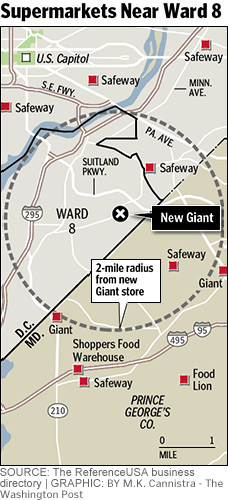Food deserts are really complicated places
A culinary-food webforum in Chicago linked to one of my entries on food deserts and in turn offers an interesting link to a journal article of a study in the UK:
Appetite. 2005 Oct;45(2):195-7.
Do 'food deserts' influence fruit and vegetable consumption?--A cross-sectional study.
Pearson T, Russell J, Campbell MJ, Barker ME.
Public Health GIS Unit, School of Health and Related Research, University of Sheffield, Regent Court, Sheffield S1 4DA, UK.
Lack of access to affordable healthy foods has been suggested to be a contributory factor to poor diet. This study investigated associations between diet and access to supermarkets, transport, fruit and vegetable price and deprivation, in a region divergent in geography and socio-economic indices. A postal survey of 1000 addresses (response rate 42%) gathered information on family demographics, supermarket and shop use, car ownership, mobility and previous day's fruit and vegetable intake. Postcode information was used to derive road travel distance to nearest supermarket and deprivation index. Fruit and vegetable prices were assessed using a shopping basket survey. Generalised linear regression models were used to ascertain predictors of fruit and vegetable intake.
Male grocery shoppers ate less fruit than female grocery shoppers. Consumption of vegetables increased slightly with age. Deprivation, supermarket fruit and vegetable price, distance to nearest supermarket and potential difficulties with grocery shopping were not significantly associated with either fruit or vegetable consumption.
These data suggest that the three key elements of a food desert, fruit and vegetable price, socio-economic deprivation and a lack of locally available supermarkets, were not factors influencing fruit or vegetable intake. We suggest that food policies aimed at improving diet should be orientated towards changing socio-cultural attitudes towards food.

Supermarkets adjacent to Wards 7 and 8. Washington Post graphic.
Labels: food-agriculture-markets, public health



0 Comments:
Post a Comment
<< Home